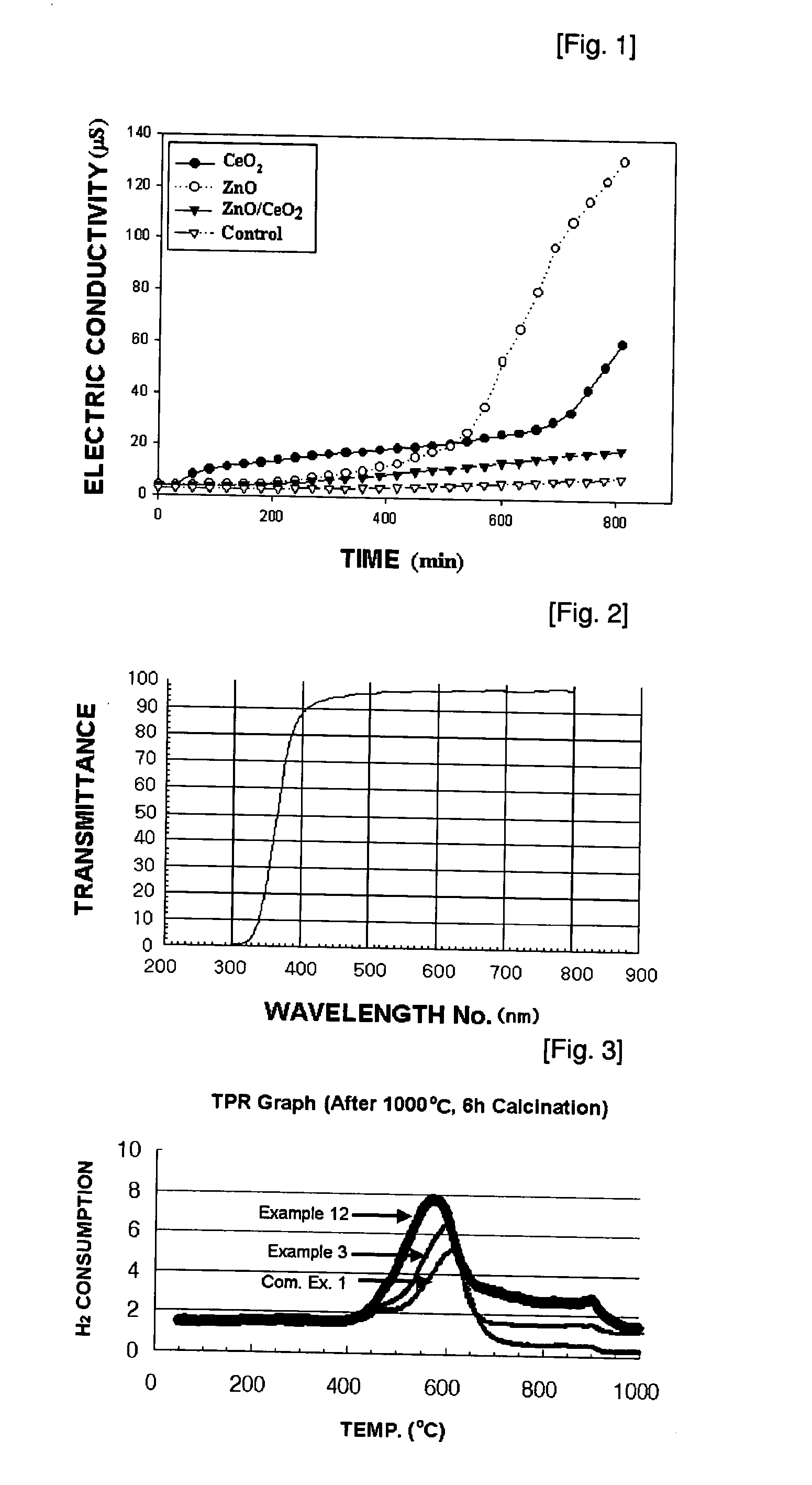Metal oxide solid solution, preparation and use thereof
a technology of metal oxide and solid solution, which is applied in the direction of zirconium compounds, bulk chemical production, lanthanide oxide/hydroxides, etc., can solve the problems of high energy consumption, low productivity, and high cost of facilities, and achieves a superior uv light shielding effect, high solid solubility, and good skin friendly
- Summary
- Abstract
- Description
- Claims
- Application Information
AI Technical Summary
Benefits of technology
Problems solved by technology
Method used
Image
Examples
example 1
[0070] While being pumped at a rate of 80 g per min through a tube having an outer diameter of ¼ inch, deionized water was preheated to 550° C. and pre-pressurized to 250 bar. Separately, while being pumped at a rate of 8 g per min through respective tubes having an outer diameter of ¼ inch, an aqueous mixed metal solution containing 0.99 wt % of yttrium nitrate and 11.0 wt % of zirconium nitrate. While being pumped at a rate of 8 g per min through a tube having an outer diameter of ¼ inch, 36.1 wt % ammonia water was pressurized to 250 bar. The aqueous mixed metal solution containing yttrium nitrate and zirconium nitrate was mixed with the ammonia water in a primary mixer (primary mixing) and then with the preheated and pre-pressurized water under a pressurized condition in a secondary mixer (secondary mixing), followed by reaction at 400° C. for 0.2 sec. The concentration of the metal nitrates was 1.0 wt % in total. The slurry thus produced was cooled and centrifuged to isolate pa...
example 2
[0072] While being pumped at a rate of 35 g per min through a tube having an outer diameter of ¼ inch, deionized water was preheated to 510° C. and pre-pressurized to 300 bar. Separately, while being pumped at a rate of 4 g per min through a tube having an outer diameter of ¼ inch, an aqueous mixed metal solution containing 8.97 wt % of cerium nitrate and 1.54 wt % of zinc nitrate was pressurized to 300 bar. Apart from the aqueous mixed metal solution, while being pumped at a rate of 3 g per min through a tube having an outer diameter of ¼ inch, 6.43 wt % ammonia water was pressurized to 300 bar. Under a pressurized condition, the aqueous solution containing cerium nitrate and zinc nitrate, the ammonia water, and the pre-heated and pre-pressurized deionized water were mixed in a mixer, followed by reaction for 0.8 sec at 385° C. The concentration of the metal nitrates was 1.0 wt % in total. The slurry thus produced was cooled and centrifuged to isolate particles.
[0073] The particle...
example 3
[0078] While being pumped at a rate of 80 g per min through a tube having an outer diameter of ¼ inch, deionized water was preheated to 550° C. and pre-pressurized to 250 bar. Separately, while being pumped at a rate of 8 g per min through respective tubes having an outer diameter of ¼ inch, an aqueous mixed metal solution containing 13.95 wt % of zirconium nitrate and 4.05 wt % of cerium nitrate was pressurized to 250 bar. While being pumped at a rate of 8 g per min through a tube having an outer diameter of ¼ inch, 18 wt % ammonia water were pressurized to 250 bar. Under a pressurized condition, the aqueous solution containing zirconium nitrate and cerium nitrate, the ammonia water, and the pre-heated and pre-pressurized deionized water were mixed in a mixer, followed by reaction for 0.2 sec at 380° C. The slurry thus produced was cooled and used to isolate particles therefrom. These particles were dried at 100° C. in an oven, followed by calcination for six hours in furnaces of 9...
PUM
| Property | Measurement | Unit |
|---|---|---|
| crystallite size | aaaaa | aaaaa |
| crystallite size | aaaaa | aaaaa |
| specific surface area | aaaaa | aaaaa |
Abstract
Description
Claims
Application Information
 Login to View More
Login to View More - R&D
- Intellectual Property
- Life Sciences
- Materials
- Tech Scout
- Unparalleled Data Quality
- Higher Quality Content
- 60% Fewer Hallucinations
Browse by: Latest US Patents, China's latest patents, Technical Efficacy Thesaurus, Application Domain, Technology Topic, Popular Technical Reports.
© 2025 PatSnap. All rights reserved.Legal|Privacy policy|Modern Slavery Act Transparency Statement|Sitemap|About US| Contact US: help@patsnap.com

